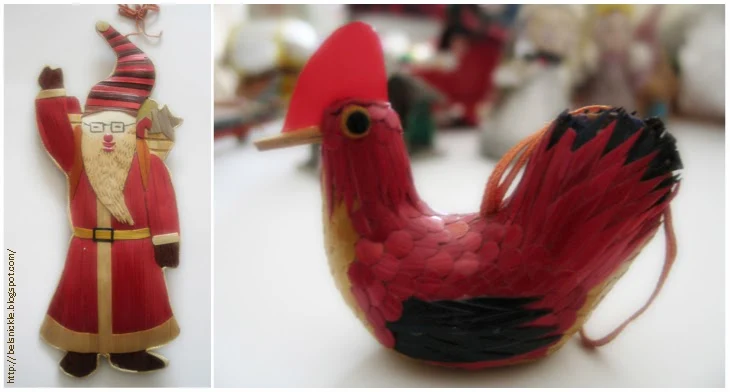 |
| pasted wheat bell |
Straw patchwork, shown left and below, is a Chinese folk art that dates back to the Han Dynasty (250—230 CE) and developed during Sui Dynasty of 581—618 CE. During the Song Dynasty (960—1127 CE), straw patchwork was enjoyed by royalty. Wheat straw is smoked, steams, whitening, dyed, cut, and altered in a myriad of procedures to fashion delicate representational works. Today wheat straw patchwork is a decorative art and popular item for tourists to China. Above I have included a variety of photographs depicting straw patchwork used to create Christmas ornaments for the Western Christmas markets by Asian countries like China, Japan, and Taiwan.
 |
| This straw patchwork ornament took it's design from a Trogen horse. |
Straw plaiting is a method of manufacturing textiles by braiding straw. It is plaited to produce products including straw hats and ornaments, and the process is undertaken in a number of locations worldwide. Straw can be plaited for a number of purposes, including: the crafting of a paper-making material, for ornamenting small
surfaces as a "straw-mosaic", for plaiting into door and table mats,
mattresses and for weaving and plaiting into light baskets and to create
artificial flowers. Straw is also plaited to produce a variety of Christmas ornaments like those shown below.
"A Year of Swedish Slöjd (Handcraft)" at the American Swedish Institute is a multi-dimensional project funded in part by the Minnesota State Arts Board through a Folk and Traditional Arts grant. In a series of youth and adult workshops, participants worked together with guest artists from throughout Minnesota, creating beautiful and functional objects out of ceramic tile, wood, birch bark, glass, wire, wheat, and felted wool. The instructor of the Wheat Weaving workshops was Carol Tamte.
This activity is made possible in part by a grant provided by the
Minnesota State Arts Board, through an appropriation by the Minnesota
State Legislature from the Minnesota arts and cultural heritage fund
with money from the vote of the people of Minnesota on November 4,
2008."
- Examples of Flat Polish Straw Stars
- Scandinavian Christmas Magic at the Ekenäs castle
- Putting out the hare, putting on the harvest knots
- The Guild of Straw Craftsmen - Links
- Simple Raffia Braids




No comments:
Post a Comment
Constructive comments are appreciated. All comments are moderated and do not immediately appear after publishing. I don't publish spam folks. Thanks and have a nice day!